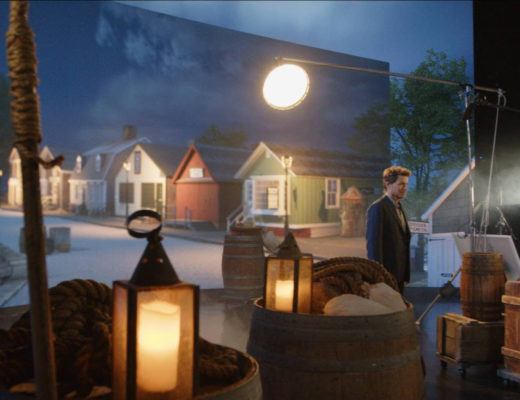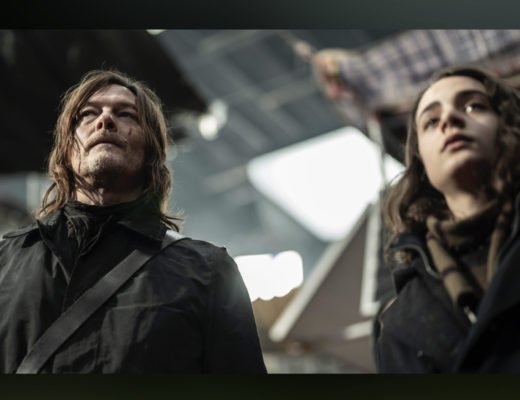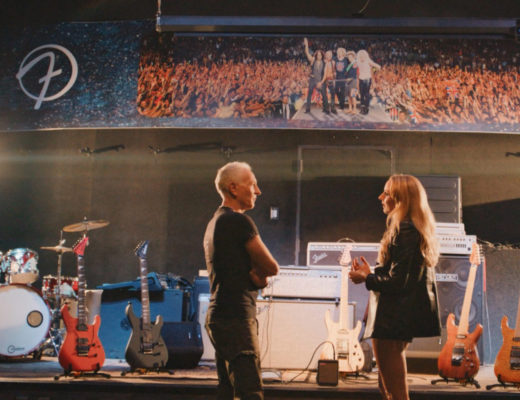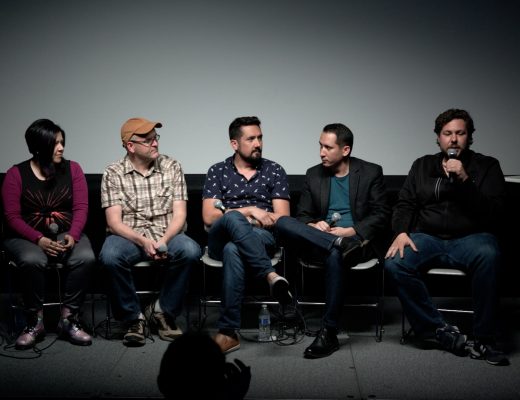 Hit band Blood Incantation uses DaVinci Resolve for editing, grading and VFX to help with complex storylines in their latest music video, the science fiction saga of “The Stargate”. It’s a labor of love.
Hit band Blood Incantation uses DaVinci Resolve for editing, grading and VFX to help with complex storylines in their latest music video, the science fiction saga of “The Stargate”. It’s a labor of love.
More short film than music video, “The Stargate” presents the epic story of a mysterious object and its victims. Beginning in the Dark Ages and traveling into the voids of deep space, it blends science fiction and folk horror with interdimensional travel and otherworldly technology. Followers of the band’s evolution are familiar with the different videos produced, which are some of the most high-quality music videos used to illustrate songs, but “The Stargate” music video, which at more than 20 minutes is longer than previous videos, feels like a step forward, in the right direction.
The band has a few official videos on YouTube, and you should check them, starting with Inner Paths (to Outer Space), from five years ago, to Luminescent Bridge, published eight months ago, to better understand the path that leads to The Stargate music video. At a confluence of metal and psychedelic music, the band’s evolution led to the creation of the Stargate Research Society, introduced as “a metaphysical publishing organization that encourages personal investigation of the infinite mysteries of the Mind and Cosmos”, which first appears in 2020, and points to the recent The Stargate”.
The influences from the original TV series and films are evident, as are the roots of the group’s music: in an interview published by The Big Take Over, drummer Isaac Faulk mentions the names of Pink Floyd Brian Eno, Tangerine Dream, Klaus Schulze, Can, Faust and Amon Düül II, as the music he listened to and adds “we’re very influenced by stuff like King Crimson and Yes and Gentle Giant, those more technical prog bands.”

A contender for my AOTY says Mike Portnoy
The interview also helps to understand the band and the music video “The Stargate”, and so does the recent documentary “All Gates Open: In Search of Absolute Elsewhere” which tells the story of Blood Incantation’s time in Berlin during the summer of 2023, recording “Absolute Elsewhere” at the legendary Hansa Studios, where David Bowie made ‘Low’ and ‘Heroes’, and Iggy Pop, Depeche Mode and U2 recorded some of their best music, and also saw the presences of stars and bands like Nick Cave and the Bad Seeds or the REM.
When the album Absolute Elsewhere was released, drummer Mike Portnoy from the band Dream Theater, wrote on Instagram about the “incredible” new album and how “The brutality of Opeth meets the beauty of Pink Floyd… all in one Epic Prog Metal album (just two 20 minute epics!)” adding that it is “definitely a contender for my AOTY (Album of the Year).”
 “The Stargate” music video, a 20-minute saga featuring mind bending imagery and unsettling atmospheres, takes a new step forward in the exploration of images and the sound of the band. It’s like a “metal opera” that uses music as a tapestry to tell a story. The short film was edited and color graded in DaVinci Resolve Studio with visual effects (VFX) completed using the post production software’s Fusion page. The video’s Director and DP Michael Ragen was responsible for the edit and VFX, while Colorist Belal Hibri completed the grade for the short movie.
“The Stargate” music video, a 20-minute saga featuring mind bending imagery and unsettling atmospheres, takes a new step forward in the exploration of images and the sound of the band. It’s like a “metal opera” that uses music as a tapestry to tell a story. The short film was edited and color graded in DaVinci Resolve Studio with visual effects (VFX) completed using the post production software’s Fusion page. The video’s Director and DP Michael Ragen was responsible for the edit and VFX, while Colorist Belal Hibri completed the grade for the short movie.
“This film is an exploration of portals, worlds beyond worlds, and places beyond time,” explained Ragen. “Because it’s so complex, I built out the entire edit to the song using text cards in Resolve initially. Just simple descriptions of what would be happening in every shot. This was key to staying on schedule and shooting exactly what we needed with our limited resources and time.”
 Transition from black and white to color
Transition from black and white to color
“Once we started shooting, I ping ponged between filming, editing, working on VFX, and also doing temp color correction,” he added. “The biggest thing that convinced me to switch to Resolve for editing was the ability to jump into the color page at any time and work on temp grades. I’m primarily a cinematographer so having the right look really helps me dial in the edit, especially on something like this where we transition from black and white to color.”
 Ragen also noted that if he found himself stuck while editing, he could switch gears, simply click over to DaVinci Resolve Studio’s Fusion page, and work on compositing a shot.
Ragen also noted that if he found himself stuck while editing, he could switch gears, simply click over to DaVinci Resolve Studio’s Fusion page, and work on compositing a shot.
“In Fusion, I used the planar tracker to track part of someone’s face, then used a secondary take of them and stabilized their head movement with the planar tracker. Next, I took elements of that take and composited it onto the first shot, making them into multi featured mutants,” he said.
According to Ragen, the space shots required traditional compositing with basic 3D elements such as animated particle fields that the camera pans through. “All the organic elements in the space backgrounds were filmed in camera by Chris Parks, who is a master at fluid effects and has worked on films like ‘The Fountain’ and ‘The Tree of Life,’” he explained. “I would take multiple shots from him and stack them or warp them into a new background in Fusion, then bring in the ship, as an EXR or PNG sequence with transparency. The ship itself was something I initially built as a practical miniature and then 3D scanned and did additional 3D kitbashing in Unreal Engine.”
 A good reminder of what filmmaking can be
A good reminder of what filmmaking can be
Additional tools essential to Ragen’s work included DaVinci Resolve Studio’s inspector with built in stabilization and retiming tools. “On the color page, personally I would never get too fancy with the nodes in the temp color, but I did end up stacking a lot of FX in there, such as some of the warp and dent tools, as well as Analog Damage,” he said.
According to Hibri, Ragen had a clear vision for the music video’s various phases. “I would describe it as a raw photochemical look that you might see in a low budget sci fi film from the 70s. This matched the analog methods used to record and mix the music as well as the approach to VFX. When we got into the actual grading, it became about sculpting that look in a way that responded to density and layering that you can hear in the recording. In addition to the color palette, we used grain, glow, halation and lens flares in different intensities and styles to distinguish each of the various genres and tonalities in the tracks,” he said.
 Hibri continued, “Close to the end of the video, the pilot loses control, and the music and editing get really wild. The scene blends different types of footage from Chris Parks’ macro photography to shots of bubbling fluids to shots of the band members melting as they enter the star. We worked hard to ensure that the sequence flowed together and kept up with the intensity of the moment. We had shots where we blended four types of scanned film grain to fuse them into the rest of the edit and keep the energy flowing. There is a moment when it all comes together, and it’s immensely satisfying when the sound and image match each other.”
Hibri continued, “Close to the end of the video, the pilot loses control, and the music and editing get really wild. The scene blends different types of footage from Chris Parks’ macro photography to shots of bubbling fluids to shots of the band members melting as they enter the star. We worked hard to ensure that the sequence flowed together and kept up with the intensity of the moment. We had shots where we blended four types of scanned film grain to fuse them into the rest of the edit and keep the energy flowing. There is a moment when it all comes together, and it’s immensely satisfying when the sound and image match each other.”
“We were lucky to work with a band that was so trusting in us and gave us the creative freedom to realize this vision but at the same time were incredibly hands on and collaborative throughout the process,” Ragen concluded. “The team we had was also amazing. It really felt like working with a bunch of friends on something fun, not a job, however challenging it may have been. It was a good reminder of what filmmaking can be when it feels like there is a common artistic goal.”

Filmtools
Filmmakers go-to destination for pre-production, production & post production equipment!
Shop Now













